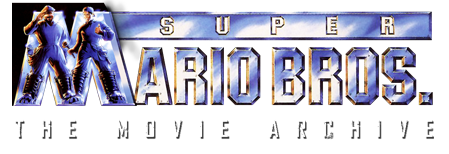Guest Editorial: "Why The Super Mario Bros. Movie Is So Misunderstood"
Written by: Kate Willaert
Posted: November 20, 2019
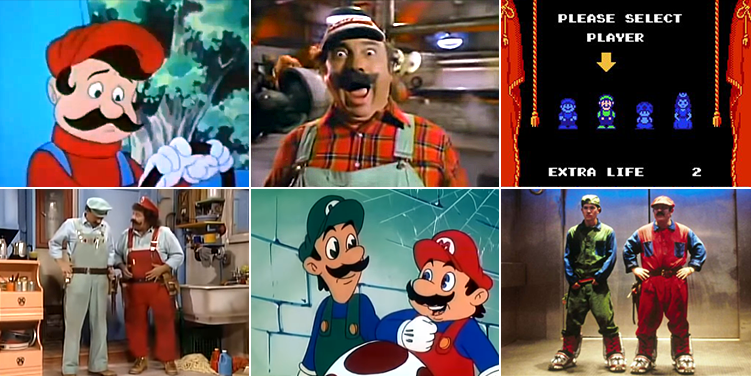
The live-action film Super Mario Bros., based on the popular Nintendo series of the same name, is typically described as some combination of the following:
- Hollywood’s first video game adaptation.
- A troubled production.
- A critical and commercial failure.
- The worst video game movie of all time.
All of these statements are true, except for the last one.
Anyone who calls Super Mario Bros. the worst movie of all time clearly hasn’t sampled the oeuvre of Uwe Boll, let alone fully experienced the entirety of the video game movie canon. Did you know there have been forty-two theatrical releases as of this writing? I’ve watched every single one — because I hate myself — and let me tell you: not only is Super Mario Bros. nowhere near the worst, it’s actually among the better ones!
Yet its undeserved bad reputation has led it to be relegated to cinematic obscurity. It can’t be legally streamed on any online service, and you can’t even buy it on Blu-Ray unless you have a Region 2 player.
Despite its flaws, I can’t think of a film more deserving of a cinematic re-evaluation.
What a wonderful concept, re-evaluation. A critical and commercial failure like Citizen Kane can be re-evaluated as a timeless masterpiece, while a critical and commercial success like Crash can be re-evaluated as the worst film of the decade. And then they can be re-re-evaluated by those who disagree!
I’ve even seen attempts to reevaluate Tim Burton’s Batman films as two of the worst Batman films. The core complaint might sound familiar: that the movies stray too much from the source material. But I want to take a moment to deconstruct that thought.
Because Tim Burton might not realize it, but he was inadvertently responsible for both the creation and destruction of Super Mario Bros.
Batman Begins It
When I hear people say Tim Burton’s Batman doesn’t act like Batman, my first thought is always: which Batman?
Batman has been reinterpreted an endless number of times, and our personal interpretation of the character based on which incarnations we’re most familiar with. In the world of the 1980s, there was no Batman: TAS or Batman Begins. The general public’s understanding of Batman was based exclusively on the campy ‘60s TV show, and reimagining the character for a Hollywood movie meant managing those preconceived notions.

Batman and Joker from comic to TV to movie
I don’t view Tim Burton’s films as a poor adaptation of the comics, but as a wonderfully twisted adaptation of the campy TV show, with some elements from the then-current comics thrown in.
So you’ve got the stunt casting and gadgets galore from the TV show mixed with the tall ears and atmosphere of the ‘80s comics, plus a few uniquely-Burton contributions.
One of my favorite new additions is Bruce Wayne’s personality. Previously, he sort of didn’t have one. He was just kind of a generic playboy, always less interesting outside the suit than in it, a problem that Tony Stark also suffered from until Robert Downey, Jr. gave him a personality injection in the first Iron Man film. Bruce Wayne’s personality injection turned him into quirky eccentric who’s so entertaining that Michael Keaton is still considered the fan favorite Bruce Wayne, even when he’s not their favorite Batman.
Unfortunately, while Marvel embraced Stark’s new personality in the comics, DC ignored Wayne’s. A lot of fans are strongly opposed to the source material adopting ideas from introduced in adaptations, but it happens more often than you think. I mean, Superman couldn’t fly until an adaptation did it.
And then there’s the Ninja Turtles.

Donatello and Michaelangelo from comic to TV to movie
Teenage Mutant Ninja Turtles started out as a semi-parody of Frank Miller’s Daredevil in which they fought The Foot instead of The Hand. The characters all looked the same and talked the same, and could only be told apart by what weapon they were holding. They had the slightest hint of individual character traits, but it was largely overshadowed by dialogue that was mostly interchangeable.
It was the cartoon that first gave them distinct personalities, as well as their love of surfer lingo and pizza, not to mention the colored masks. The movie was meant to be an adaptation of the comics, but it couldn’t ignore these new elements from the popular cartoon.
Critics were not happy about this new trend of dark “kiddie” films, but there was no denying they did well at the box office.
Which brings us to Super Mario Bros.

Mario and Luigi. from video game to TV to movie
In the Fall of 1989, between the theatrical releases of Batman (Summer 1989) and Teenage Mutant Ninja Turtles (Spring 1990), Nintendo made their first big push into mass media with The Wizard, Captain N: The Game Master, and most importantly, the Super Mario Bros. Super Show.
Super Show paired animated segments with campy live-action skits that featured celebrity guest stars. But video games were an even greater challenge to adapt because they typically contained far less to work from in terms of stories and characterization. They were blank slates that could be taken in just about any direction.
Before Super Show, Mario appeared in Donkey Kong segments of 1983’s Saturday Supercade, and you’d barely recognize him. The familiar plumber is instead an unfamiliar circus owner, with the tenacious can-do attitude (and accent) of a Scooby Doo lead.
Luigi made his TV debut that same year, in a live-action commercial for the Atari port of the arcade game Mario Bros. Back then they were identical twins, so you’d easily mistake him for his brother if he hadn’t been sing-shouting “Mario, where are you!?” Someone should’ve told him Mario was over on Supercade.
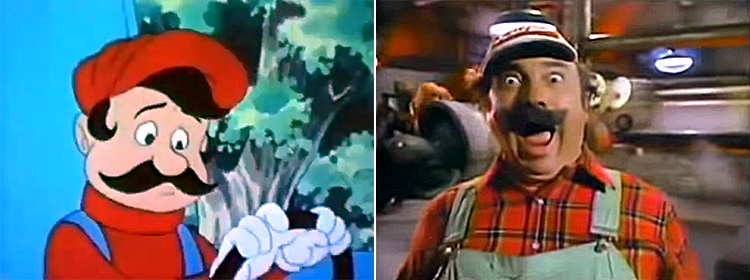
Mario in Saturday Supercade, Luigi in a commercial for Mario Bros.
Luigi’s tall-and-skinny redesign first appeared in 1988’s Super Mario Bros. 2, but didn’t immediately stick. Although his new was look carried over to the manuals for Super Mario Bros. 3 and Super Mario World, in-game he remained Mario’s twin. But most fans at the time weren’t paying that much attention. Princess Toadstool’s hair color changed in nearly every game, and it didn’t seem to bother anyone. Nothing about these characters was really locked in place.
So how do you adapt something that’s so flexible and undefined that even the heroes professions changed to reflect whatever the current game required?
Super Show had to lock some things down, at least for internal consistency. Princess Toadstool was a redhead like the first game, Luigi was tall-and-skinny like the second game. The big bad looked like a cross between Bowser and Wart was called “King Koopa.”
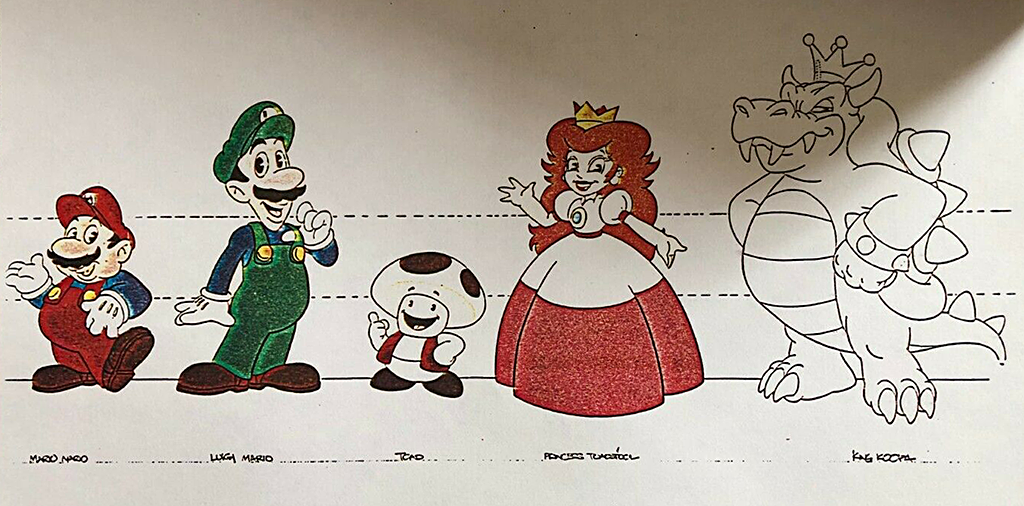
Note their last names.
They also had to invent personalities for the characters. They decided Mario would be the impulsive and adventurous one, while Luigi would be cautious and timid. They also invented an origin in which the brothers were Brooklyn natives who owned a plumbing company and found a warp pipe to the Mushroom Kingdom. (Later, the games established that they’d actually lived in the Mushroom Kingdom since they were babies.)
But the show was so influential that a lot of this stuck. For nearly a decade, kids “knew” that Mario’s arch-enemy was “King Koopa,” despite every instruction manual calling him “Bowser.” The directors of the Super Mario Bros. movie were even given a choice between “Bowser” and “King Koopa,” and went with the latter.
(Incidentally, Bowser is known as simply “Koopa” in Japan, and one of the great gaming mysteries is who at Nintendo Of America named him “Bowser,” and why they were insistent on keeping that name even after Princess Toadstool became “Peach.”)
What I’m saying is, I don’t view the Super Mario Bros. movie as a poor adaptation of the comics, but as a wonderfully twisted adaptation of the campy TV show, with some elements from the then-current games thrown in.
And that’s why I have fun when I watch it. It’s Mario through a very Burton-esque lens, to the extent that the temp track they edited to leaned heavily on Danny Elfman tracks. Sure, it was a little weird the first time I saw it that they flipped the characters personalities from the show, but it was such a creative take that I didn’t mind.
On the other hand, if there’s one thing everyone can agree on, it’s that the opening narration sequence is legitimately awful. They say you only have one chance to make a first impression, and that one was particularly bad. To this day I wonder how much that opening has to do with its bad reputation.
Because I don’t think most kids at the time actually hated the movie itself that much. Sure, the critics hated it, the critics also hated Teenage Mutant Ninja Turtles.
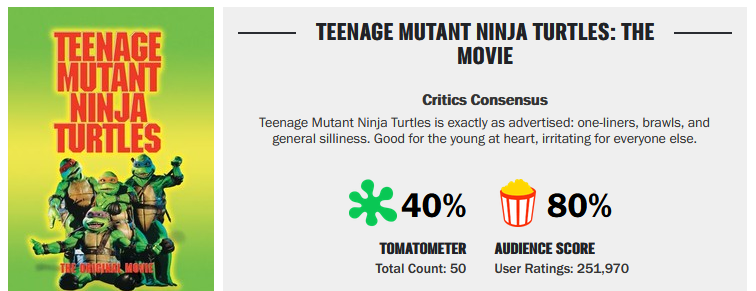
Source: RottenTomatoes.com.
They gave Batman a free pass, maybe because they grew up Batman so he felt familiar. But the Ninja Turtles (and Mario) were new and unfamiliar to adults in the ‘90s, and they had trouble seeing the movies as anything but an excuse to sell toys.
But the negative reviews had no impact on the success of Teenage Mutant Ninja Turtles. So what was the REAL reason Super Mario Bros. bombed?
Or to put it another way: Teenage Mutant Ninja Turtles III was released just two months before Super Mario Bros., and despite being awful still made twice as much as Super Mario Bros. So what really happened?
I have a theory.
Batman Ends It
I don’t think there was anything bigger than Batman in 1992. The studio took marketing to a whole new level. Did you know Batman Returns was the first movie to do individual character posters? True story.
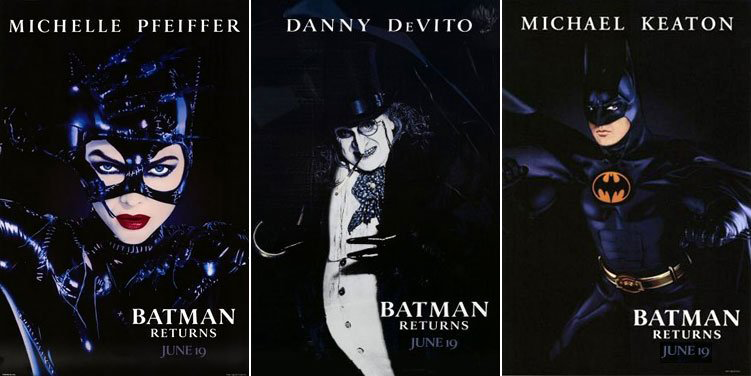
aracter posters for Batman Returns
They also went all-in on toys, including McDonald’s Happy Meal tie-ins. Normally this might’ve seemed like a big risk for a sequel that was going to be even darker than the first, but the previous year Kenner did toys for Terminator 2: Judgement Day, and that movie was Rated R! Kids are digging this darker stuff, right?
Well, it backfired. Batman Returns was just a little too dark for PG-13. Kids cried. Parents complained. McDonald’s gave the studio an earful. From that point on, the studio decided, Batman movies would be lighter and more “toyetic.”
But do you know what movie was being filmed during Batman Returns’ theatrical run?
Super Mario Bros.
How many parents do you figure felt so burned by Batman Returns that they vowed not to take their kids to anymore dark “kiddie” films? Hell, even the Ninja Turtles sequels lightened things up with a PG rating.
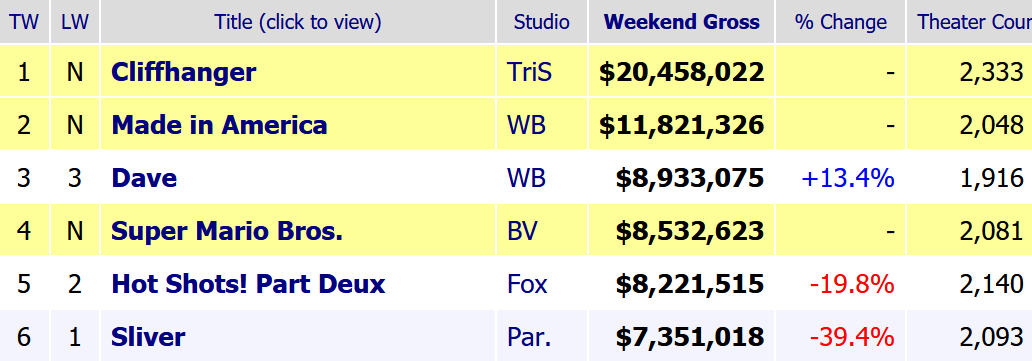
Source: BoxOfficeMojo.com.
That’s the kids, but what about the teens and adults? Apparently they all went to see Silvester Stallone’s Cliffhanger, which opened the same day. Others were saving their money to see Jurassic Park two weeks later.
So the real reason Super Mario Bros. bombed? Maybe it was just one year too late. Even Tim Burton’s all ages adaptations have changed.
Kate Willaert saw Batman Returns in the theater at age 8, and was only mildly scarred for life. You can follow her on Twitter @katewillaert or donate to her Patreon.
